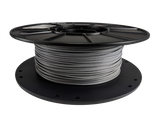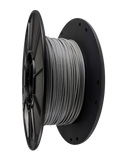Glass Filled PLA - 500g (1.1lbs) Spool
Glass Filled PLA 3D printer filament is an engineering-grade filament that can be used on any machine capable of printing standard PLA. Glass Filled PLA filament offers similar benefits of standard PLA such as a very low warp, low odor, and printing without a heated bed. The glass fibers added to the composite make-up allows it to be stronger, tougher and more flexible than parts 3D printed in standard PLA.
In a comparison to parts 3D printed in standard PLA, Glass Filled PLA parts are:
- 1.4 times stronger than PLA at 57 MPa of max tensile strength.
- 1.3 times tougher than PLA with 34 J/m of Impact Toughness.
- 1.9 times more flexible than PLA with a tensile elongation of 3.4% before failure.
Note: Printing with composite filaments containing hard materials such as Glass-filled PLA can cause increased wear in 3D printer nozzles made out of brass or other relatively soft materials. We recommend upgrading to a steel or hardened extruder nozzle if you plan on doing extensive printing with these materials.
500g (1.1lbs) spools
| Glass Filled PLA | |
| Recommended Extrusion Temperature: | Glass Filled PLA prints well at 180-210 C. These are general starting points for Glass Filled PLA, actual temperatures will vary from one printer to another. |
| Recommended Nozzle size: | 0.5mm or larger diameter nozzles. Smaller diameter nozzles can be used but have a higher likelihood of clogging. |
|
Recommended Retraction Settings: |
0.25mm per 0.1mm of nozzle diameter (ie. 1.25mm retraction when using a 0.5mm diameter nozzle) |
|
Recommended Print Surface: |
Hot - A heated bed is not necessary, though if you have one, set it to 40 C. Cold - Blue Painter's tape, glass with a coat of glue, Buildtak surfaces PLA bonds very firmly to acrylic. Printing directly on an acrylic surface is not recommended. |
|
Print Cooling fan? |
Print cooling fans are highly recommended with PLA-based filaments and usually result in a very noticeable improvement in the appearance of the print. Print cooling fans also greatly improve the ability to bridge gaps and print overhanging areas without support when using PLA-based filaments. |













